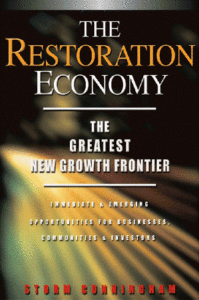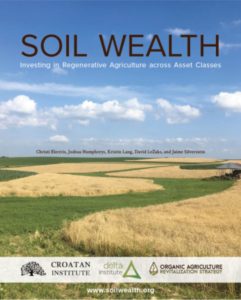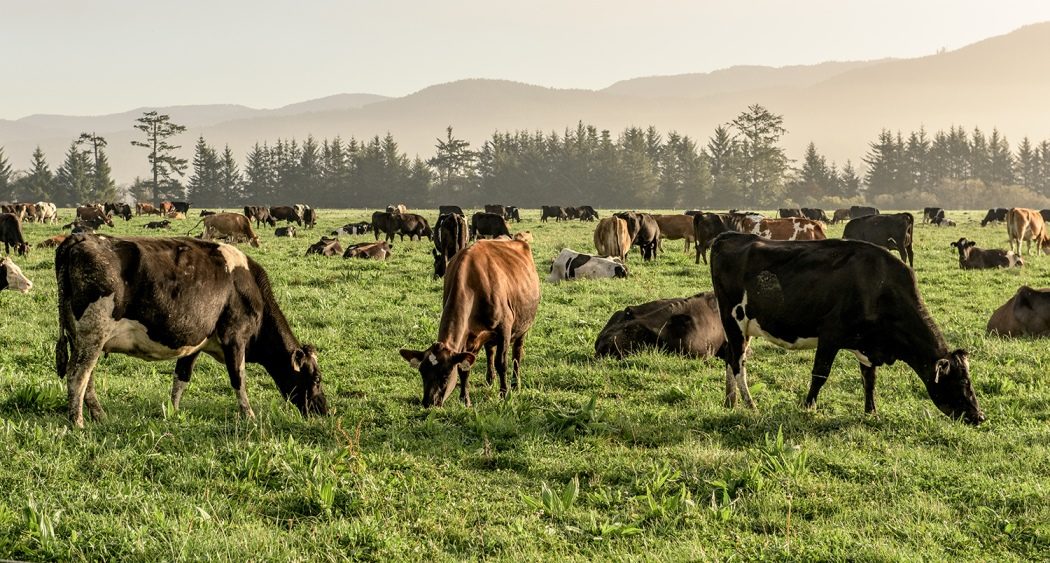Back in 2002, my first book, The Restoration Economy, had a chapter on regenerative agriculture, which showed how it was the future of farming and ranching.
 It took a while, but the trend has finally gained major momentum.
It took a while, but the trend has finally gained major momentum.
On July 10, 2019, a team of researchers from Croatan Institute, Delta Institute, and the Organic Agriculture Revitalization Strategy (OARS) released a major new report for investors, agriculture practitioners, entrepreneurs, and philanthropists on financing regenerative agriculture.
The report highlights 127 investments totaling $321.1 billion that explicitly integrate sustainable food and agriculture in their investment processes, with 70 of those strategies with combined assets of $47.5 billion including regenerative agricultural criteria in their investment strategy as well.
The new report, Soil Wealth: Investing in Regenerative Agriculture across Asset Classes, is the most comprehensive look to date at the US landscape of investment opportunities in regenerative agriculture — one of the leading trends in food and agriculture today. Regenerative agriculture refers to a diverse array of farming systems that enhance the biodiversity of farming landscapes, improve soil health and the water cycle, and strengthen the resilience of rural agricultural economies.
The report provides an in-depth analysis not only of investments in farmland, but also of investment opportunities across asset classes that support regenerative agricultural value chains and food systems, including banking and cash equivalents, fixed-income investing in both public and private debt markets, public equities, and the private equity and venture capital market.
Across these asset classes, it identifies 67 distinct investment mechanisms, instruments, and approaches for further developing regenerative agriculture capital opportunities. The report concludes with a series of recommendations for investors and stakeholders to build greater “soil wealth” — the benefits associated with improving soil health and increasing rural wealth through regenerative agriculture.
Soil Wealth stems from a major, three-year project on innovative mechanisms for financing regenerative agriculture funded by a Conservation Innovation Grant from the US Department of Agriculture’s Natural Resources Conservation Service (NRCS).
“For years investors have claimed that there are few viable options for investing in more regenerative food systems. This report has documented existing strategies across asset classes, and the steps to take to unleash the many forms of capital needed to transform our food systems into ones that build soil health and community wealth,” said Dr. David LeZaks, Regenerative Food Systems Lead at Delta Institute, director of the NRCS Conservation Innovation Grant that funded the project, and co-author of the report.
Other key components of the report include:
 Identification of financial mechanisms and approaches across asset classes, some of which are commonly used in traditional conservation or agricultural finance that could be utilized to support regenerative agriculture outcomes;
Identification of financial mechanisms and approaches across asset classes, some of which are commonly used in traditional conservation or agricultural finance that could be utilized to support regenerative agriculture outcomes;
Quantitative analysis of the current state of investment funds across asset classes that are currently financing sustainable food and agriculture or regenerative agriculture; and
A roadmap for the development of new investment opportunities in the capital markets incorporating regenerative agriculture criteria that could accelerate the transition of conventional agriculture to regenerative farmland.
The increasing need to address climate change has generated significant investment interest in regenerative agriculture. Implementing climate-friendly, regenerative agricultural practices could mitigate nearly 170 GtCO2e, while generating a nearly $10 trillion net financial return for investors and producers.
To realize this climate mitigation potential, more than $700 billion in estimated net capital expenditure over the next 30 years will be required. Regenerative agriculture outcomes also align with UN Sustainable Development Goals, which sustainable, responsible, and impact investors are increasingly integrating into investment decision-making frameworks.
Dr. Joshua Humphreys, President and Senior Fellow at Croatan Institute, Senior Strategist of OARS, and lead author of the report noted, “Amid what is increasingly looking like a new farm crisis, this important research advances our understanding of how to finance the transition to much more diversified, regenerative farming systems that build soil health, sequester carbon, increase biodiversity, and foster greater resilience on farms and across rural communities.”
Croatan Institute’s Summary of the Soil Wealth Report
“Soil Wealth” is what we call the constellation of benefits associated with building both soil health and community wealth through regenerative agriculture.
As the investment community in the United States, particularly within the fields of sustainable, responsible, and impact (SRI) investing, shows an increasing appetite for investing in sustainable agriculture and food systems across asset classes, a subset of investors is demonstrating growing interest in financing not simply “sustainable” agriculture but agriculture that is deemed explicitly “regenerative.”
What “regenerative” means for farmers and investors remains highly in flux, but broadly it refers to holistic approaches to agricultural systems that work with natural systems to restore, improve, and enhance the biological vitality, carrying capacity, and “ecosystem services” of farming landscapes. Regenerative farming operations also aim to support the resilience of the rural communities and broader value chains in which they are situated.
In order to advance the potential that regenerative agriculture presents in mitigating climate change, improving soil health, and building community resilience, significant capital needs to be deployed on farms, as well as across value chains. This report aims to quantify the current investment landscape surrounding regenerative agriculture and cultivate understanding of how investors can allocate investments across asset classes to further these efforts.
Based on our analyses of cash and cash equivalents, fixed income, real assets, public equity, private equity and venture capital markets, this report concludes with a series of recommendations for investors working within each asset class and for stakeholders such as foundations, policymakers, asset owners and asset managers, and regenerative agriculture practitioners.
Photo courtesy of CUESA.

